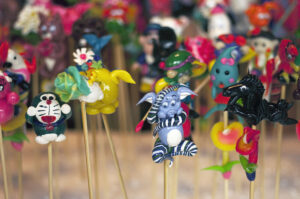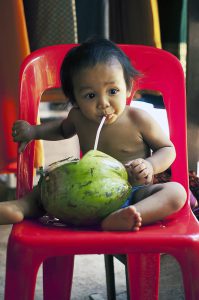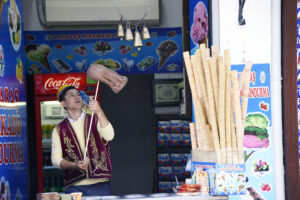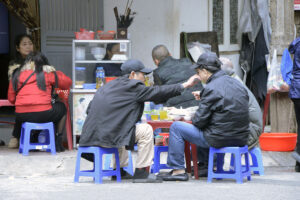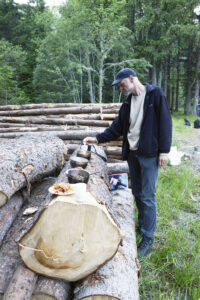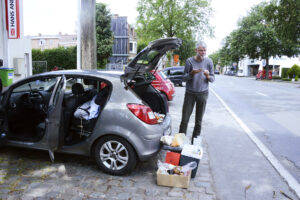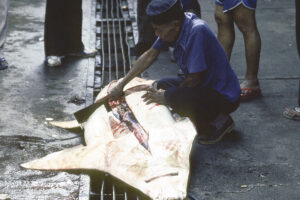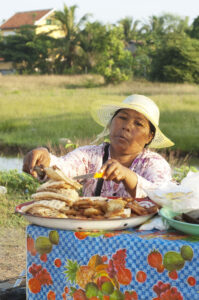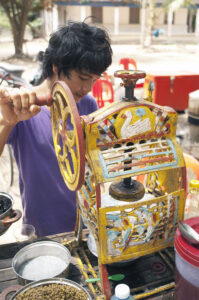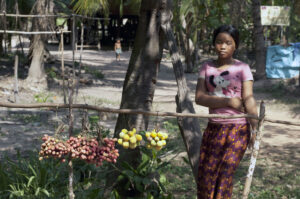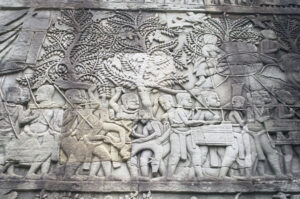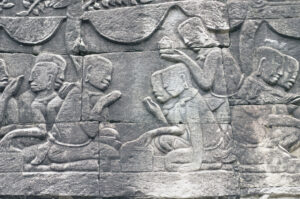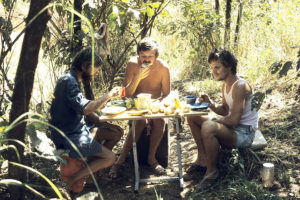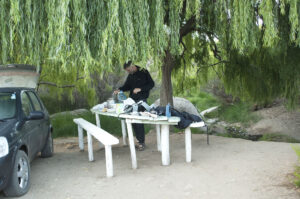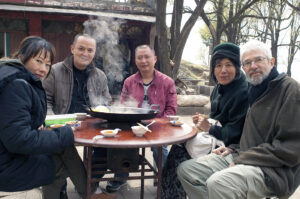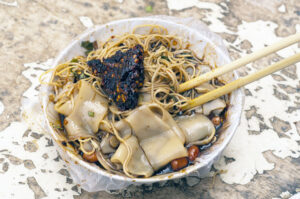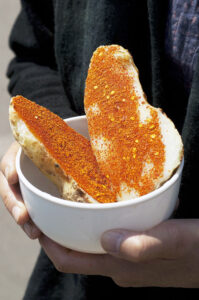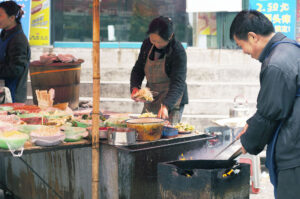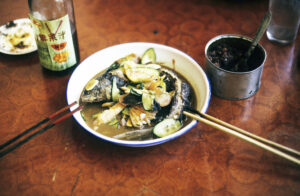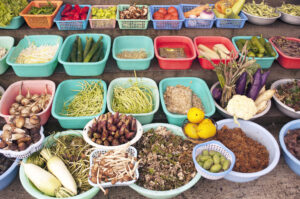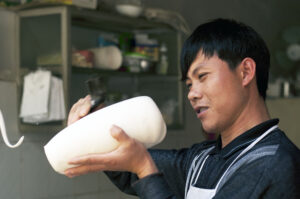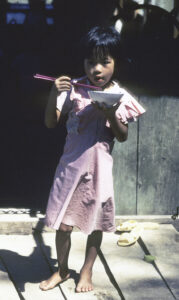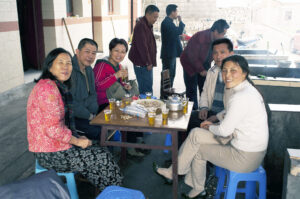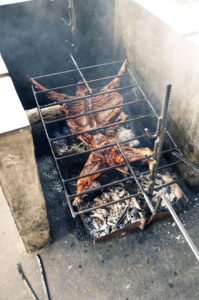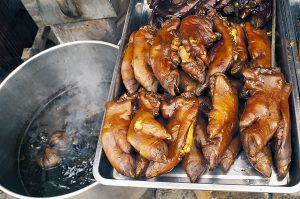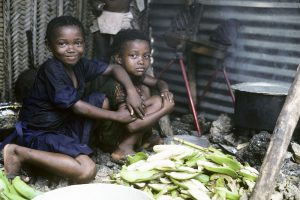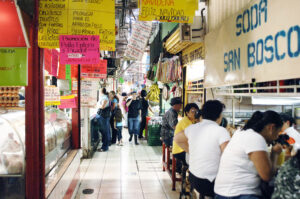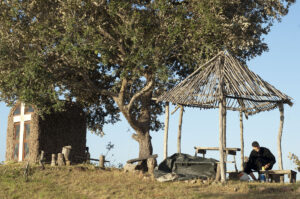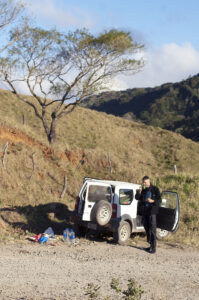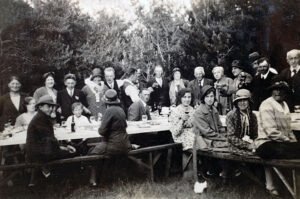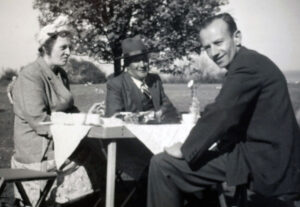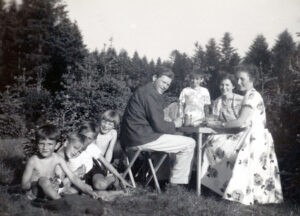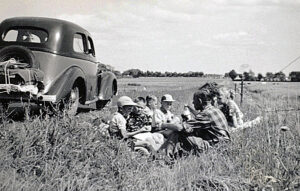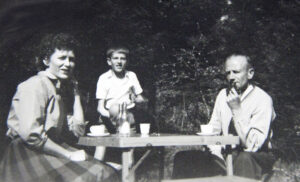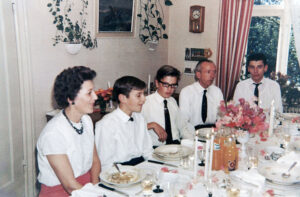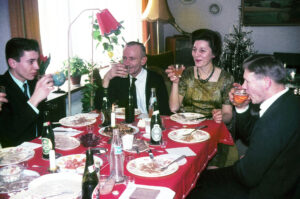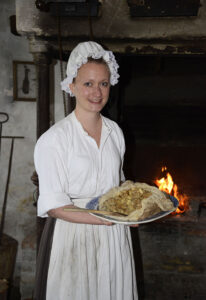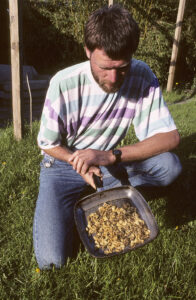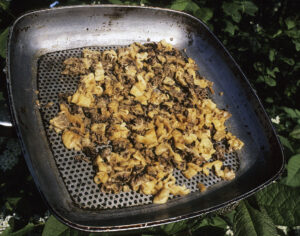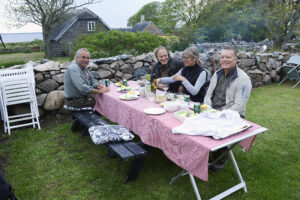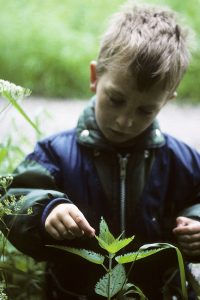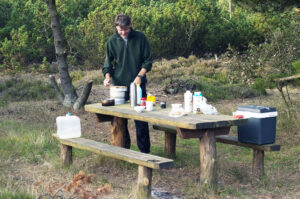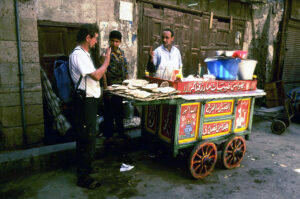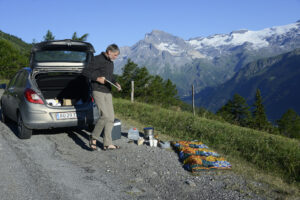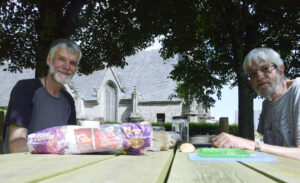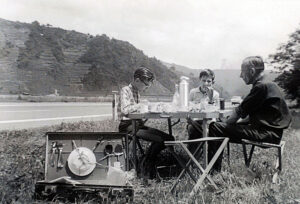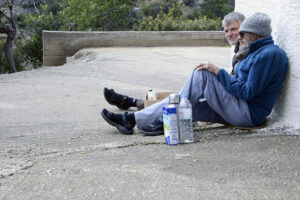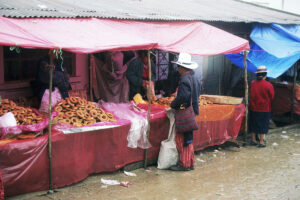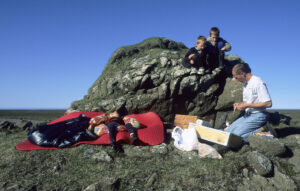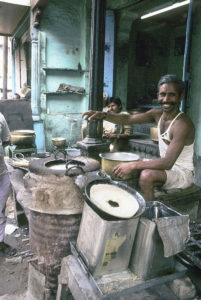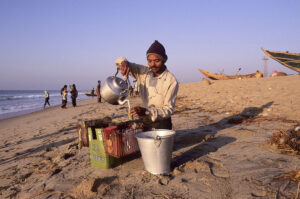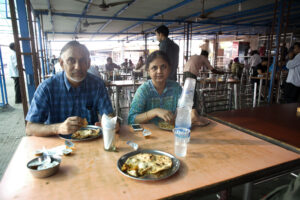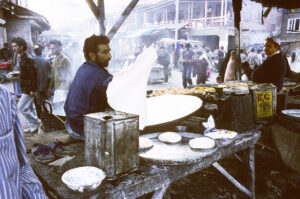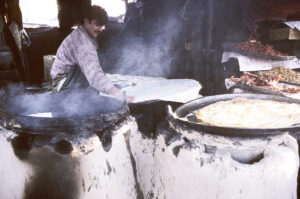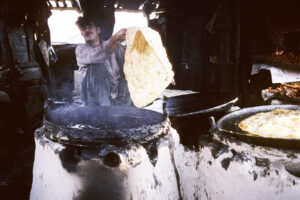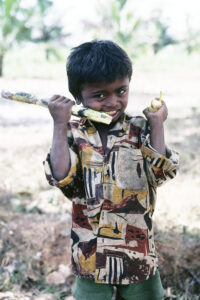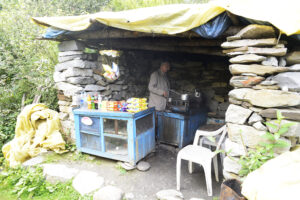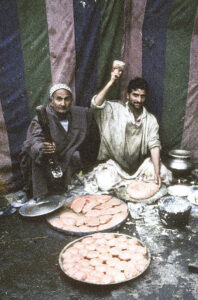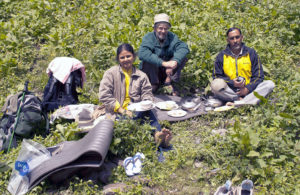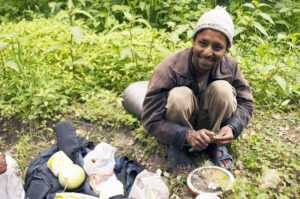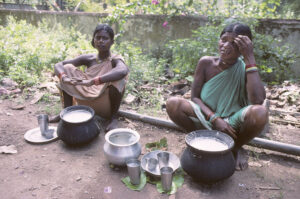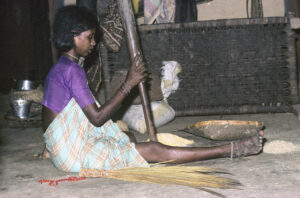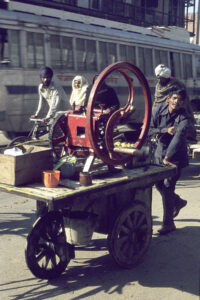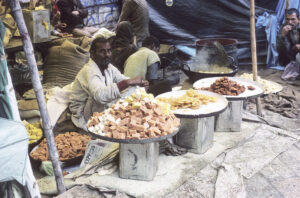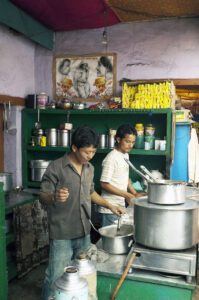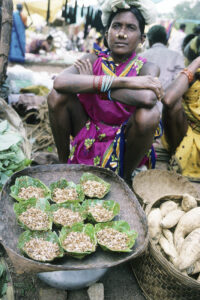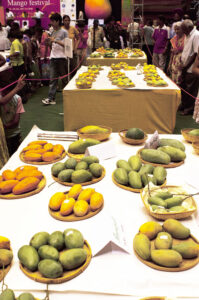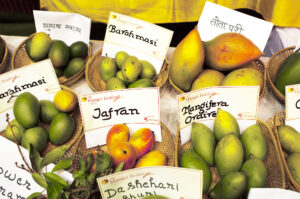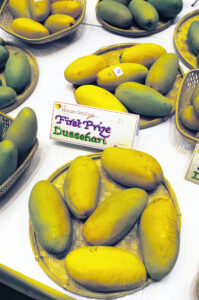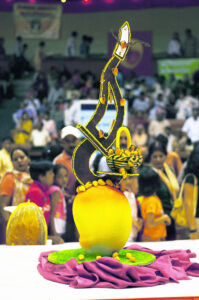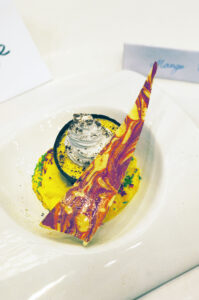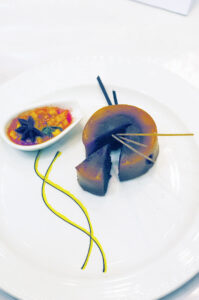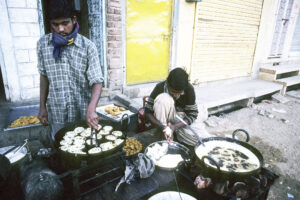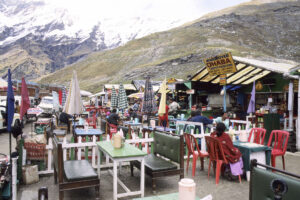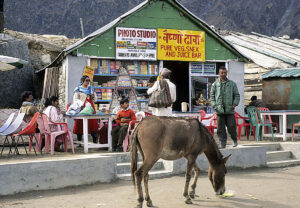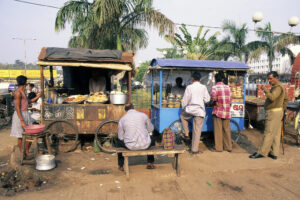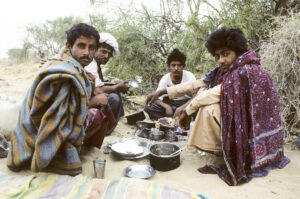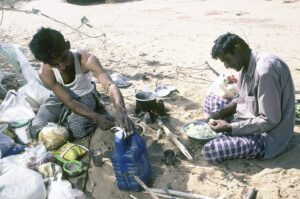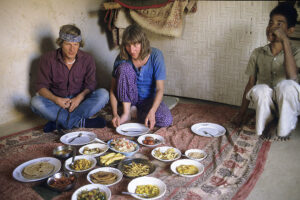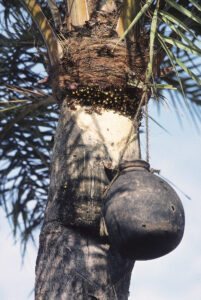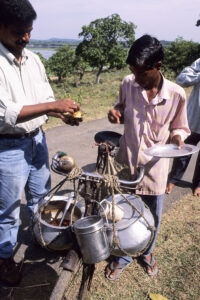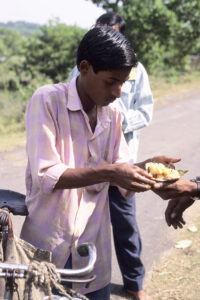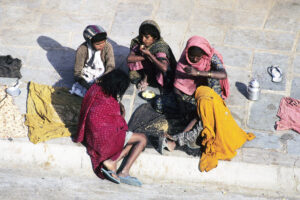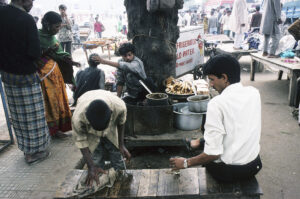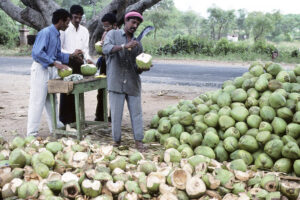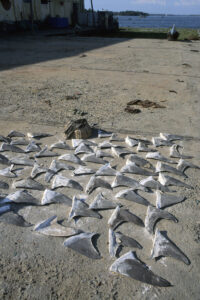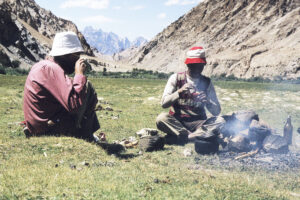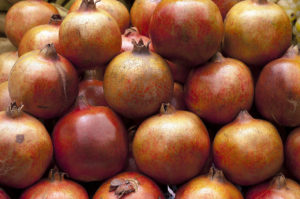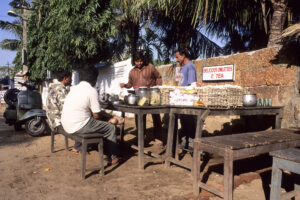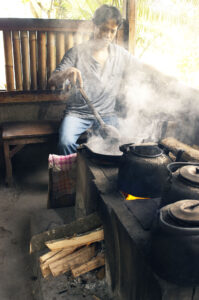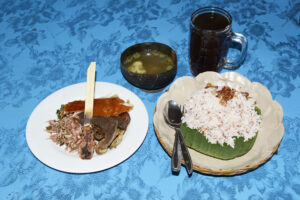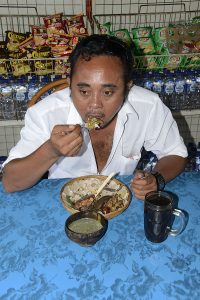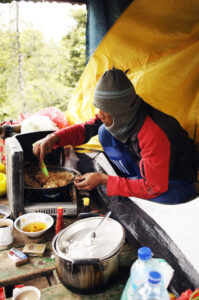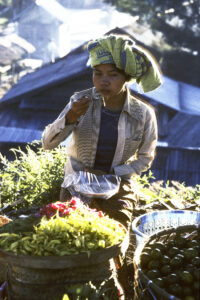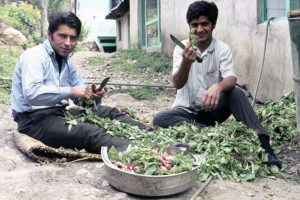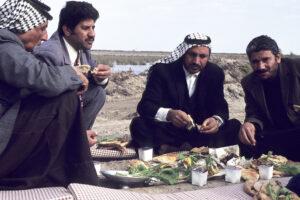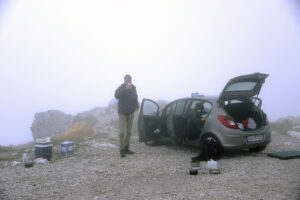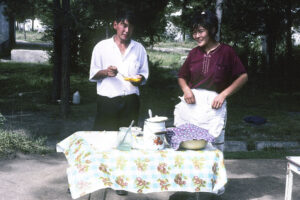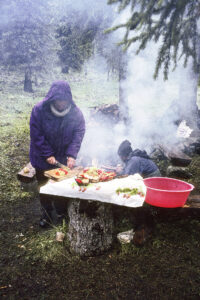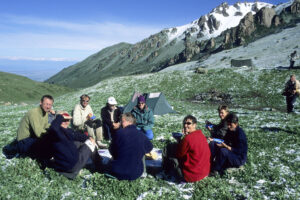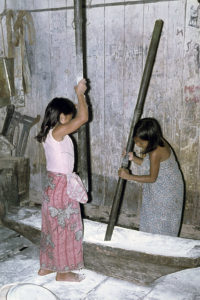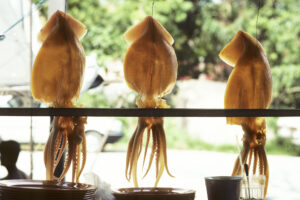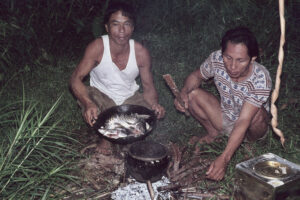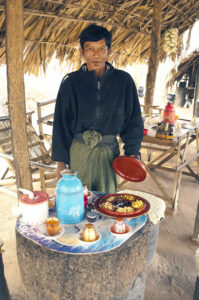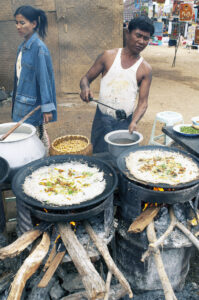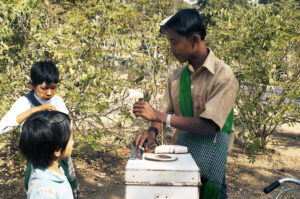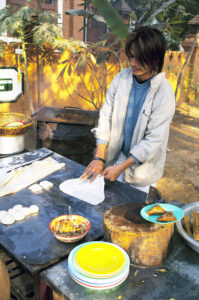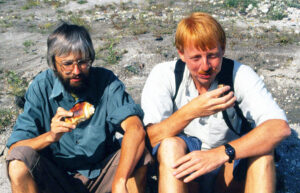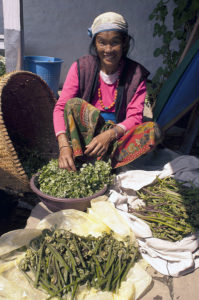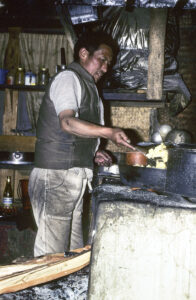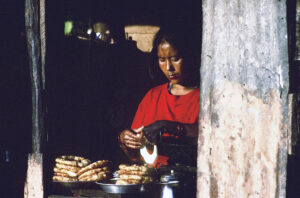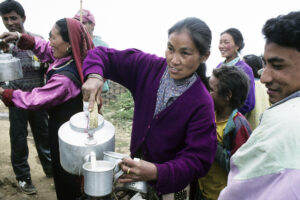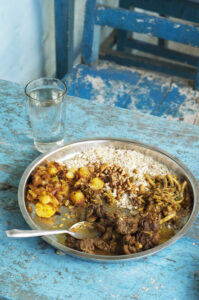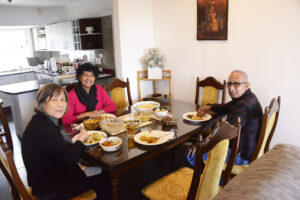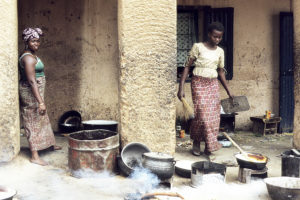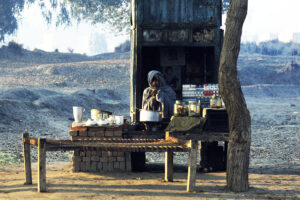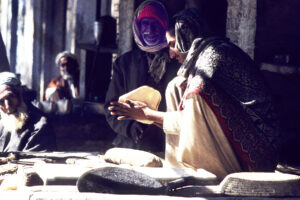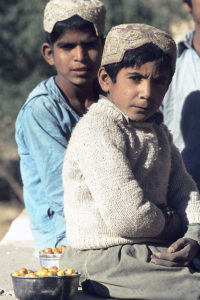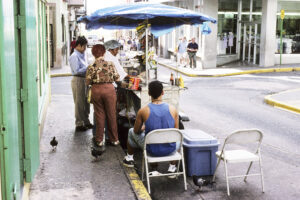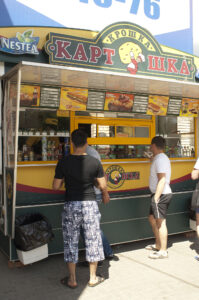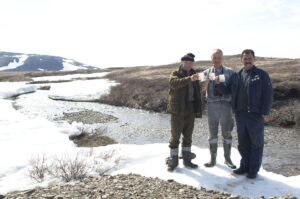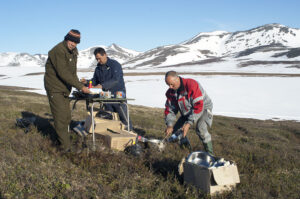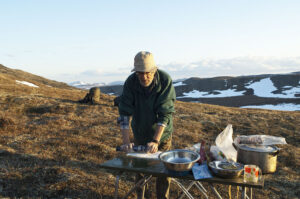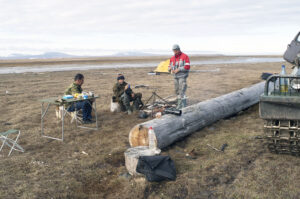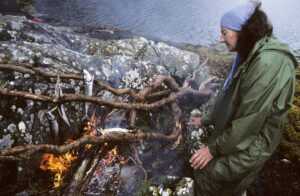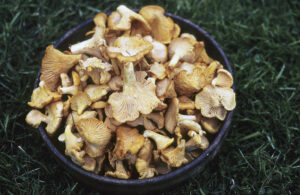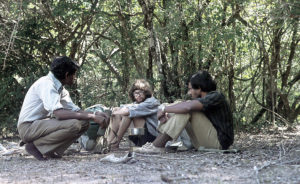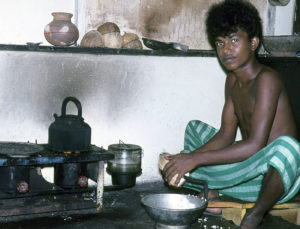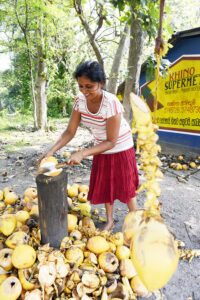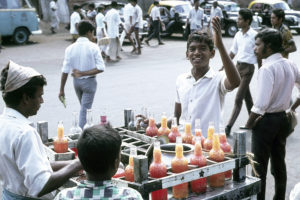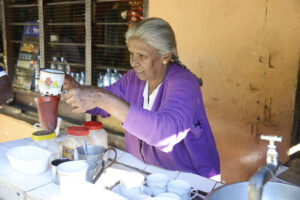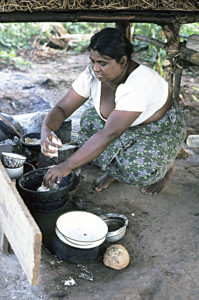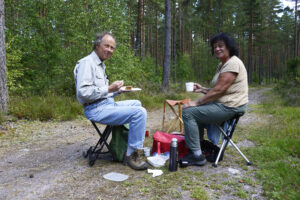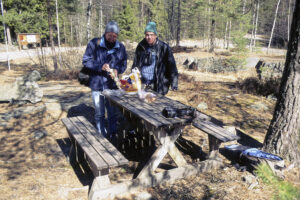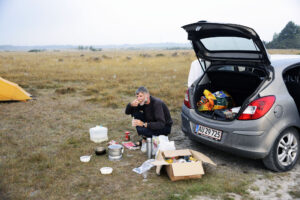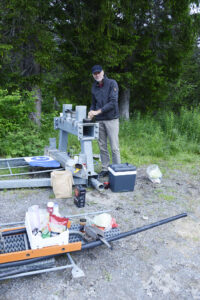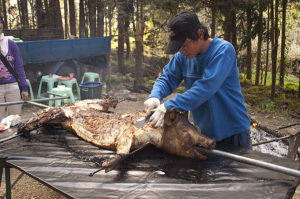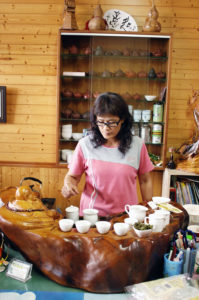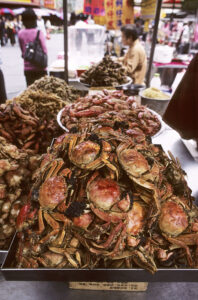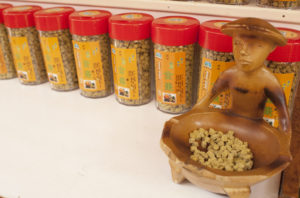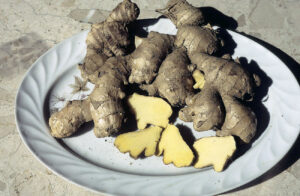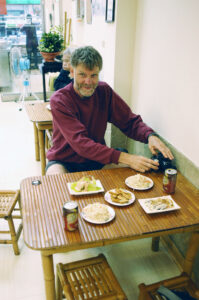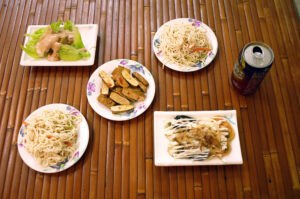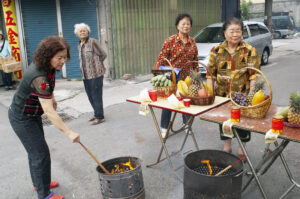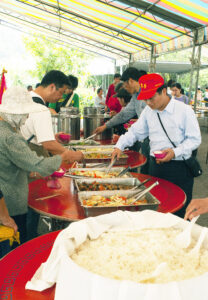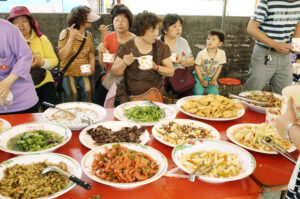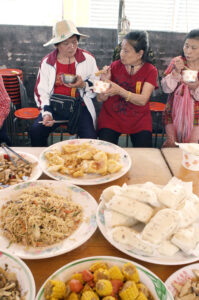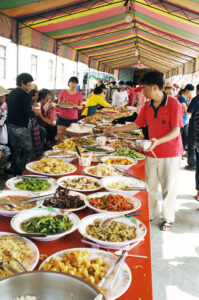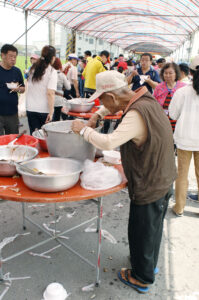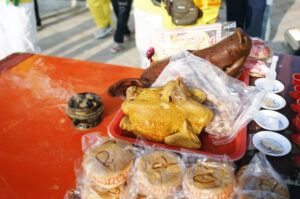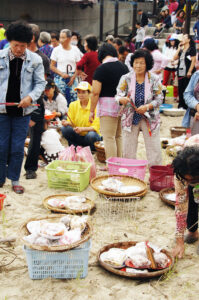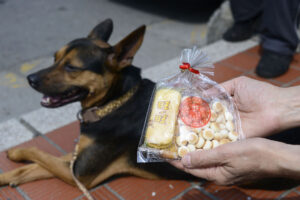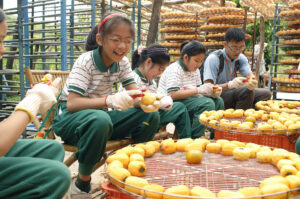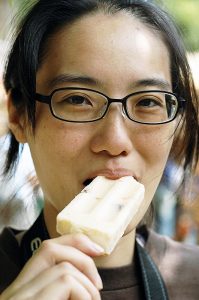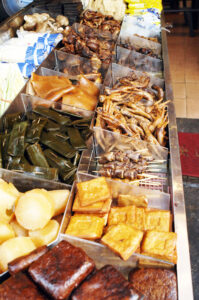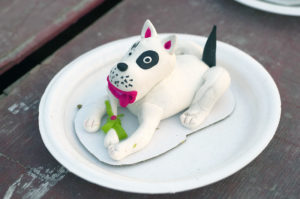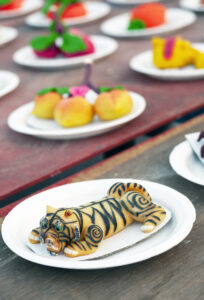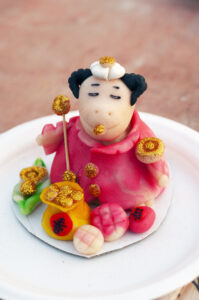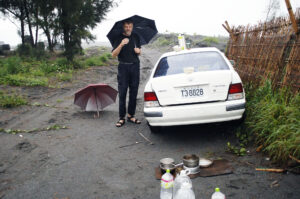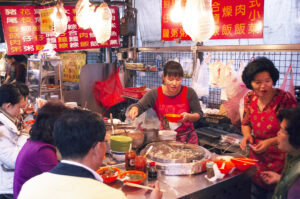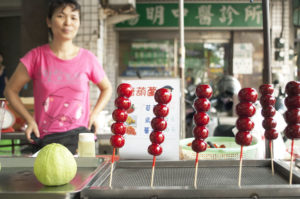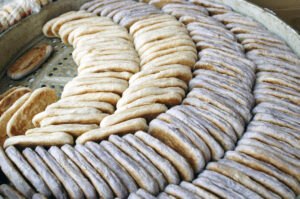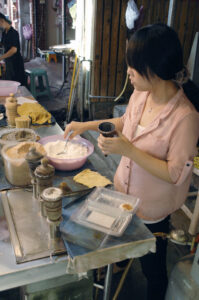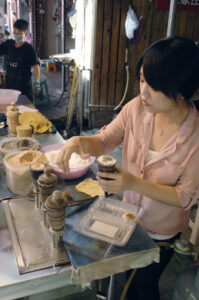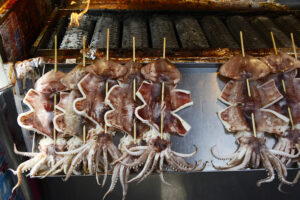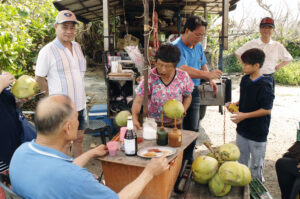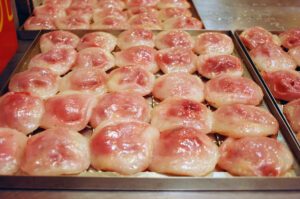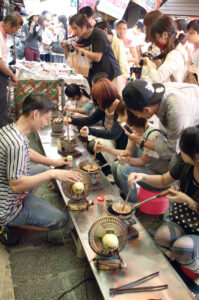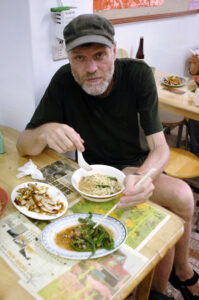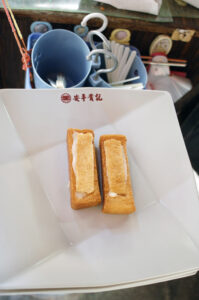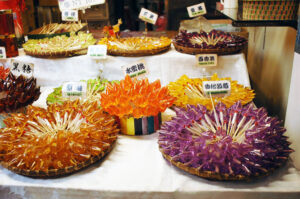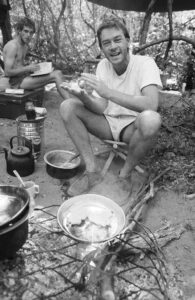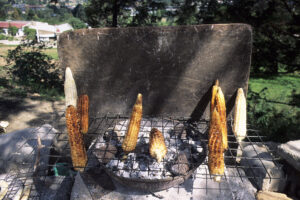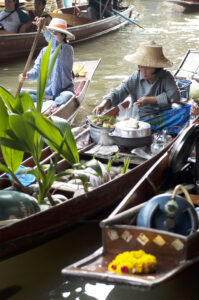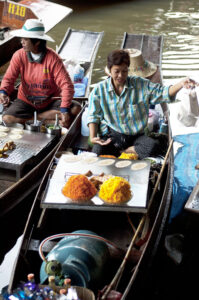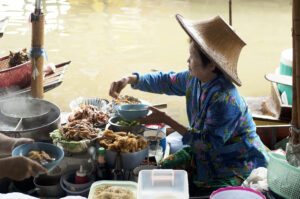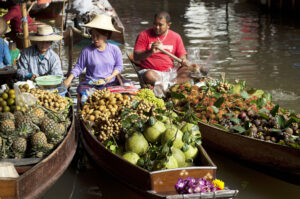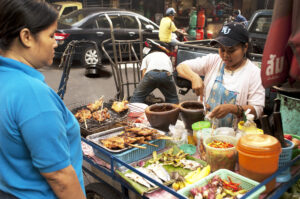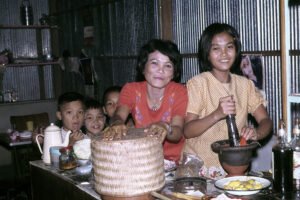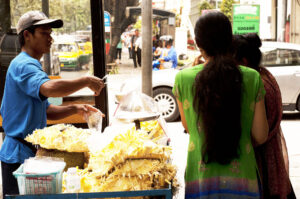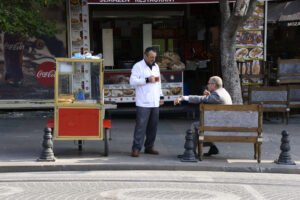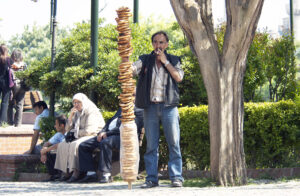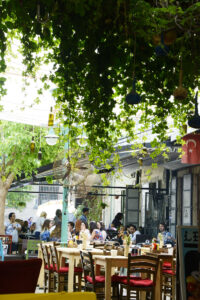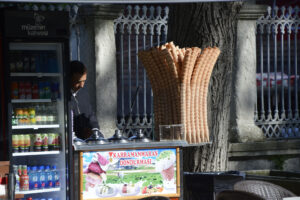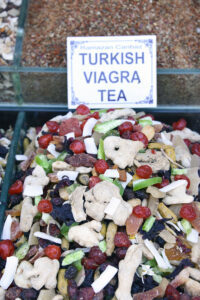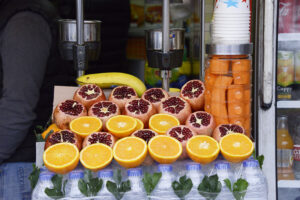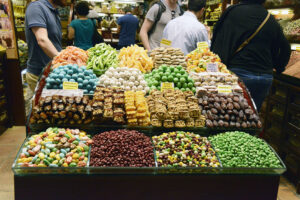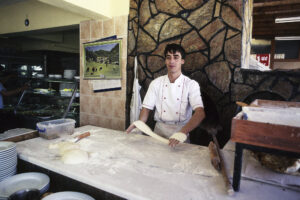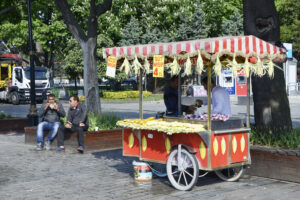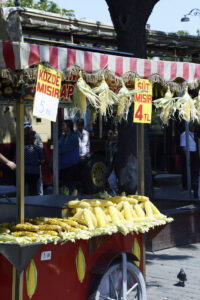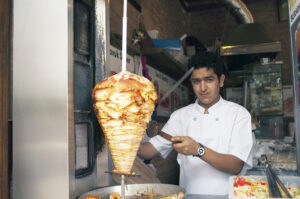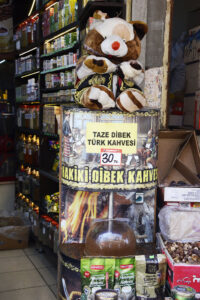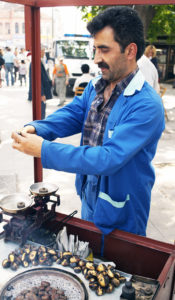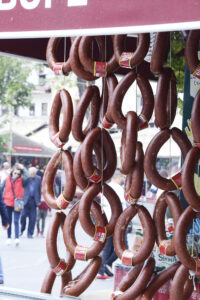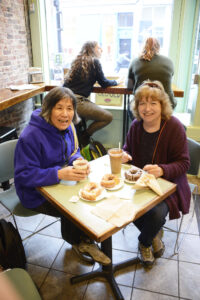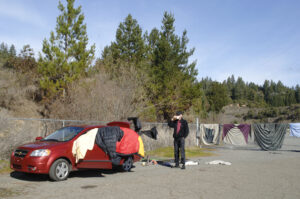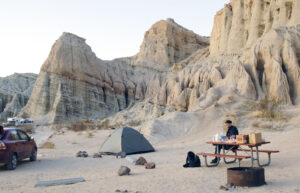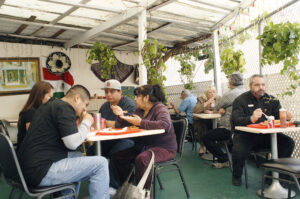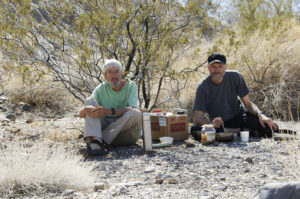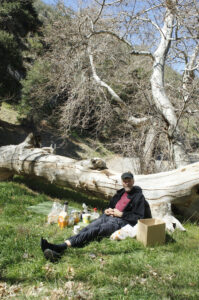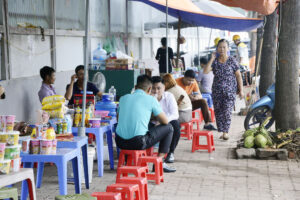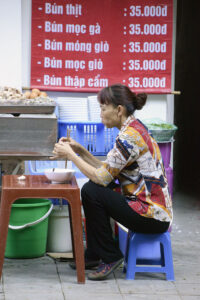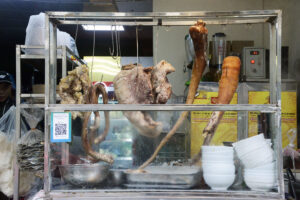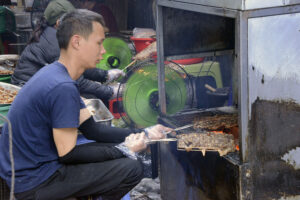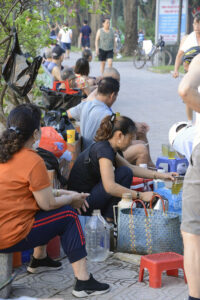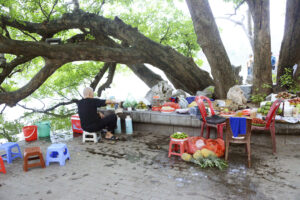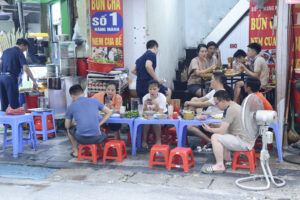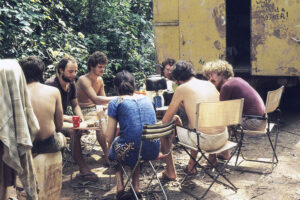Meals and snacks around the world
Colourful lollipops for sale, Sansia, Taiwan. (Photo copyright © by Kaj Halberg)
Little Khmer boy, drinking from a coconut, Angkor Wat, Cambodia. (Photo copyright © by Kaj Halberg)
Ice cream vendor, in Turkish dondurmasi, kneads the ice cream by whirling it around at the end of a stick, Istanbul, Turkey. (Photo copyright © by Kaj Halberg)
“You have something on your cheek!” – Hanoi, Vietnam. (Photo copyright © by Kaj Halberg)
Afghanistan
In the Middle East, tea is usually taken black and strong, with lots of sugar. This picture is from Kandahar. (Photo copyright © by Kaj Halberg)
Austria
These treetrunks served as a table for Lars Skipper and me during cooking, Oberwölz, near Sankt Peter am Kammersberg. (Photo copyright © by Kaj Halberg)
Lars Skipper, making preparations to cook an evening meal at a camp ground in Winklern, below Heiligenblut. (Photo copyright © by Kaj Halberg)
Belgium
At this rest area along a highway somewhere in Belgium, there were no tables or benches, so Lars Skipper enjoys his breakfast standing – and then it began to rain. (Photo copyright © by Kaj Halberg)
There were no suitable places in the city of Brugge either, so Lars enjoys his lunch standing. (Photo copyright © by Kaj Halberg)
Brunei
This man is cutting up a ray for food. (Photo copyright © by Kaj Halberg)
Cambodia
Covered outdoor restaurant, Angkor Wat. (Photo copyright © by Kaj Halberg)
Khmer woman, selling bread, Siem Reap. (Photo copyright © by Kaj Halberg)
Grinding ice for drinks, Angkor Wat. (Photo copyright © by Kaj Halberg)
Khmer girl, selling delicious lychees (Litchi chinensis, left) and other fruits, Banteay Srey, Angkor. (Photo copyright © by Kaj Halberg)
Relief, depicting a Khmer army on the march, Bayon, Angkor Thom. During the march, men cut up a deer for food. (Photo copyright © by Kaj Halberg)
This relief depicts Khmer women, eating rice with their hands, Bayon. (Photo copyright © by Kaj Halberg)
Cameroun
During a trip across Africa, we make a break to eat lunch in the forest south-east of Ngaunderé, from left me, Steffen Madsen, and Johnny Kristensen. The first part of this trip is described on the page Travel episodes – Africa 1980-81: An arduous journey across Africa. (Photo copyright © by Kaj Halberg)
Chile
Lars Skipper is served a meal in a roadside restaurant, La Caleta, Pan de Azucar National Park. (Photo copyright © by Kaj Halberg)
Lars Skipper, preparing lunch, Valle del Encanto, Ovalle. (Photo copyright © by Kaj Halberg)
‘Posada Oasis’, a roadside restaurant north of Baquedano. (Photo copyright © by Kaj Halberg)
China
On a cold spring day, a large pot of hot noodles does a lot of good! Judy and I are seated at a table outside a Buddhist temple on Fung Shan (‘Phoenix Mountain’), near Weining, Guizhou Province, together with biologist Li Ching (2nd from left), Mrs. Li (left), and our driver, Uh Tao. (Photo copyright © by Kaj Halberg)
Our meal at Fung Shan: Noodles, beans, and chili (the dark lump). The Guizhou Province is renowned for its many ways of preparing chili. (Photo copyright © by Kaj Halberg)
Fried cookies for sale, Qing Yen (‘Green Rock’), Guiyang, Guizhou Province. (Photo copyright © by Kaj Halberg)
In 1987, during a bus trip between the Nepalese border and Shigatse, Tibet, we made a stop in the small town Nyalam to eat lunch in what at first sight resembled army staff quarters. We were served a meal of rice and fried vegetables, with green jasmine tea.
This was my first experience with Chinese eating habits, and they were definitely worth a study. Using their chopsticks, people shoveled rice into their mouth, not the least concerned that some of it spilled on the table or the floor. Smacking their lips and burping, they threw gnawed chicken bones over their shoulder, and when a group had left, their table and its surroundings resembled a battlefield.
Lunch stop in Nyalam. (Photo copyright © by Kaj Halberg)
The Guizhou Province is famous for its many varieties of chili, and the many ways of using them. This picture shows boiled potatoes, sliced and dipped in chili powder. Chili is described on the page Plants: Plants in folklore and poetry. (Photo copyright © by Kaj Halberg)
Small restaurants in an alley, Chengdu, Sichuan Province. (Photo copyright © by Kaj Halberg)
Street food stall, Guiyang, Guizhou Province. (Photo copyright © by Kaj Halberg)
Chinese meal of fish, Lhasa, Tibet. (Photo copyright © by Kaj Halberg)
Judy (left), her brother Horng-i, and his colleague Miss Li, eating breakfast at a restaurant, Dali, Yunnan Province. (Photo copyright © by Kaj Halberg)
Compose your own meal! – Various foods, exhibited at a restaurant in Dali. (Photo copyright © by Kaj Halberg)
The art of cutting noodles by hand, Duyun, Guizhou Province. Note the ‘flying’ noodle to the left. (Photo copyright © by Kaj Halberg)
Little girl, eating rice with chopsticks, Yangshuo, Guangxi Zhuang. (Photo copyright © by Kaj Halberg)
At lunch somewhere in the Guizhou Province, from left Judy, her brother Horng-i, his colleague Miss Li, and his friends Mr. and Mrs. Bao. We were served barbecued dog. (Photos copyright © by Kaj Halberg)
Deep-fried pig feet for sale, Guiyang, Guizhou Province. (Photo copyright © by Kaj Halberg)
Comoro Islands
These little girls in the town of Moroni, Grande Comore, assist their mother, peeling cooking bananas. (Photo copyright © by Kaj Halberg)
Costa Rica
Restaurant in the Old Market, San José. (Photo copyright © by Kaj Halberg)
Lars Skipper, having lunch at a rest area near a Catholic chapel, Cordillera de Guanacaste. (Photo copyright © by Kaj Halberg)
Lars Skipper, drinking tea at the edge of the road, near El Dos de Tilarán, Cordillera de Tilarán. (Photo copyright © by Kaj Halberg)
During a canoe trip on the Tortuguero River, Limón, Lars Skipper eats lunch standing, as we were not able to find a suitable place to sit. (Photo copyright © by Kaj Halberg)
Denmark
Village party in Gandrup, Vendsyssel, 1929. The boy at the table to the left is my father Jens Christen Pedersen, who grew up in this village. (Photo copyright © by Kaj Halberg)
In my childhood, we often went on trips into the countryside, where we enjoyed lunch or coffee at the camping table, or at a randomly chosen roadside.
My mother’s parents Petra and Johannes Halberg, and my father Jens Christen Pedersen, enjoying their coffee in a city park, Aarhus, 1955. (Photo copyright © by Kaj Halberg)
Lunch at Vrads Sande, central Jutland, summer 1956, from left my brother Leif, me, my cousins Bruno and Jytte, my uncle Arne, my brother Per, my mother Elly, and my mother’s sister Olga. (Photo copyright © by Kaj Halberg)
Lunch at a roadside near Middelfart, Funen, 1958, from left my brother Leif, my cousin Bruno, me, my mother’s brother Jørn, my father Jens, and my cousin Jytte. (Photo copyright © by Kaj Halberg)
Enjoying coffee and soft drinks at the camping table, Lake Knudsø, central Jutland, 1962, from left my mother Elly, my brother Leif, and my father Jens, typically with his pipe in his mouth. (Foto copyright © by Kaj Halberg)
My brother Leif’s confirmation party 1965, from left my mother Elly, Leif, me, my father Jens, and my brother Per. (Photo copyright © by Kaj Halberg)
Party c. 1966, from left my brother Per, my father Jens, my mother Elly, and my uncle Arne. (Photo copyright © by Kaj Halberg)
My mother Elly, my sister-in-law Hanne, and my brother Leif, enjoying coffee and cakes, Gudenåen River, central Jutland, 2016. (Photo copyright © by Kaj Halberg)
Young woman, dressed in garments as in the 1700s, cooking a typical meal from those days (ox marrow soup with dough and various nuts) in the old-fashioned underground kitchen in Selsø Castle, northern Zealand. (Photos copyright © by Kaj Halberg)
Lars Skipper with a pan of fried common morels (Morchella esculenta), Aarhus. (Photos copyright © by Kaj Halberg)
During a stay on the islets Hirsholmene, caretaker Jens Klingenberg (left) and his wife Lise invited us for dinner (plaice). The other persons are Jens Gregersen (centre) and Jacob Funder. (Photo copyright © by Kaj Halberg)
This little boy is picking top shoots of common nettle (Urtica dioica) to be used in soup, eastern Jutland. (Photo copyright © by Kaj Halberg)
Lars Skipper, preparing dinner in the wild, Fanø, Jutland. (Photo copyright © by Kaj Halberg)
Bisquits with cheese and marmalade, Hammersholm, Bornholm. (Photo copyright © by Kaj Halberg)
Egypt
Uffe Gjøl Sørensen, buying breakfast from a colourful trolley, which serves as a tiny restaurant, Cairo. (Photo copyright © by Kaj Halberg)
France
Lars Skipper, preparing breakfast at the edge of the road, Col du Mt. Cenis, French Alps. (Photo copyright © by Kaj Halberg)
Lars Skipper and me, eating lunch at a table in a park behind the church in Confort-Meilars, Brittany. (Photo copyright © by Kaj Halberg)
Germany
Lunch break at Winningen, near Koblenz, summer 1963, from left me, my brother Leif, and my father Jens. In the background vinyards on a slope along the River Moselle. (Photo Elly Halberg, copyright © by Kaj Halberg)
Greece
An icy wind has made Lars Skipper and me seek shelter behind a small chapel to eat our lunch, near Palaiochora, southern Crete. (Photo copyright © by Kaj Halberg)
Guatemala
Bagels for sale, Todos Santos. The man is wearing the typical red-and-white-striped trousers of this town. A bagel is a type of bread roll, which originated in the Jewish communities of Poland. (Photo copyright © by Kaj Halberg)
Iceland
Ib Krag Petersen cooking, supervised by his sons Magnus and Emil, Rauðanupur, northern Iceland. To the left his daughter Sofie. (Photo copyright © by Kaj Halberg)
India
Hot tea, called chai, is an immensely popular drink in India, taken with liberal amounts of milk and sugar, and often spiced with cardamom or cinnamon. Here, a street vendor in Bikaner, Rajasthan, is heating milk to make chai. (Photo copyright © by Kaj Halberg)
Early in the morning, this vendor is selling chai and coffee on a beach near Puri, Odisha (Orissa). (Photo copyright © by Kaj Halberg)
My friends Ajai and Madhu Saxena, eating lunch at a roadside restaurant, Haryana. (Photo copyright © by Kaj Halberg)
Here, Madhu and Ajai are about to eat lunch beneath a huge tarpaulin, Sarchu, Ladakh. (Photo copyright © by Kaj Halberg)
Puri is a type of deep-fried bread, made from unleavened wheat dough. These men in Srinagar, Kashmir, are making huge puris. (Photos copyright © by Kaj Halberg)
Using his teeth, this little boy is tearing off the outer hard shell of a sugarcane stem, and then chews the white, sweet internal layer. – Kokkare Belur, near Mysore, Karnataka. (Photo copyright © by Kaj Halberg)
Tea stall, made from stones, with a tarpaulin as roof, Solang Nallah, Manali, Himachal Pradesh. (Photo copyright © by Kaj Halberg)
Cooking food for a Muslim wedding, Lake Nagin, Kashmir. The dough is beaten with a large wooden mallet. (Photo copyright © by Kaj Halberg)
During a hike in the Great Himalayan National Park, Himachal Pradesh, we make a lunch break near Rolla, Tirthan Valley. (Photo copyright © by Kaj Halberg)
Having lunch with my companions Madhu and Ajai Saxena, Ghumtarao, Great Himalayan National Park. (Photo copyright © by Kaj Halberg)
During a hike up the Sainj Valley, Great Himalayan National Park, a huge rock gives shelter to my trekking staff, while they prepare lunch. (Photo copyright © by Kaj Halberg)
Preparing to cook food on the shore of the river Bireth Nallah, Great Himalayan National Park, this man is peeling garlic. (Photo copyright © by Kaj Halberg)
Gouda tribal women, selling dahi (yoghurt), Sabari River, Odisha (Orissa). (Photo copyright © by Kaj Halberg)
People, buying breakfast at a small street stall, Delhi. (Photo copyright © by Kaj Halberg)
Maize (Zea mays) is one of the most important food sources in the world, only surpassed by rice (Oryza sativa) and wheat (Triticum aestivum). This Koya tribal woman in Odisha (Orissa), is pounding maize to make flour. (Photo copyright © by Kaj Halberg)
Sugarcane press for making juice, seasoned with spices and lemon juice, Amritsar, Punjab. (Photo copyright © by Kaj Halberg)
Street vendor, selling sweets, Kullu, Himachal Pradesh. (Photo copyright © by Kaj Halberg)
This man has a meal during preparations for a wedding in the village of Sunderpur, between Dausa and Sawai Madhopur, Rajasthan. (Photo copyright © by Kaj Halberg)
I am just about to enjoy a paper dosa, a crisp, very thin bread, made from a fermented batter of rice and black gram. It is served with coconut sauce and sambar, a hot sauce with tamarind and potato bits. – Karnataka, South India. (Photo copyright © by Søren Lauridsen)
Cooks at work in a roadside restaurant, Upshi, Ladakh. (Photo copyright © by Kaj Halberg)
This tribal woman at a market in Kotpad, Odisha (Orissa), is selling a local delicacy – ants’ eggs. (Photo copyright © by Kaj Halberg)
During a mango festival, taking place in Delhi in 2007, various types of mangos (Mangifera indica) are exhibited, besides delicious snacks produced from them. (Photos copyright © by Kaj Halberg)
Street vendors, preparing breakfast: pakora (vegetables, dipped in a batter of chick peas and then fried in oil), and jelebi (a sweet dough, fried in oil), Jaisalmer, Rajasthan. (Photo copyright © by Kaj Halberg)
Small road-side restaurants, called dhabas, below the Rohtang La Pass, Himachal Pradesh. (Photos copyright © by Kaj Halberg)
Dhabas, Bhubaneswar, Odisha (Orissa). (Photo copyright © by Kaj Halberg)
During two camel safaries in the Thar Desert, Rajasthan, our camel drivers make a stop to cook our evening meal. My adventures in the Thar Desert are described on the pages Travel episodes – India 1986: “Sir would you like to see this peacock?” and India 2003: Camel safari in the Thar Desert. (Photos copyright © by Kaj Halberg)
In the village of Khudi, in the Thar Desert, our staff tricked Lotte Møller Pedersen, Niels Peter Andreasen, and me into ordering a huge meal, which was expensive, but very delicious. This event is related on the page Travel episodes – India 1986: “Sir would you like to see this peacock?” (Photo copyright © by Kaj Halberg)
The native range of the Asian palmyra palm (Borassus flabellifer) is the Indian Subcontinent and Indochina, with disjunct populations in Java and the Lesser Sunda Islands. Its fruit is edible and sweet. A sugary sap, called toddy, can be obtained from the young inflorescence. It is fermented to make palm wine or a strong alcoholic drink, arrack. It may also be concentrated to a sweet, hard substance, in India called jaggery. It is used as a substitute for sugar. Palm wine is consumed in huge quantities in India and Sri Lanka.
Tapping juice from an Asian palmyra palm, Bodhgaya, Bihar. (Photo copyright © by Kaj Halberg)
Bicycle vendor, selling snacks containing dahi (yoghurt), Odisha (Orissa). (Photos copyright © by Kaj Halberg)
Girls, having their meal at the edge of a street, Bikaner, Rajasthan. (Photo copyright © by Kaj Halberg)
Street vendor, selling tea and snacks, Old Delhi. (Photo copyright © by Kaj Halberg)
Drinking coconuts for sale at the side of the road, south of Mysore, Karnataka. (Photo copyright © by Kaj Halberg)
Shark-fin soup is regarded as a delicacy in Chinese communities around the world, and for this reason many shark species are highly threatened. This picture shows drying shark fins on the beach at Kochi, Kerala. (Photo copyright © by Kaj Halberg)
During a hike in the Markha Valley, Ladakh, I enjoy a cup of tea, while my guide and cook prepares lunch. (Photo copyright © by Kaj Halberg)
Decorated chana (chick peas) as breakfast, Sonpur, Bihar. In the background puri (dough, which is deep-fried, until it pops up). (Photo copyright © by Kaj Halberg)
Juice of pomegranate (Punica granatum) is very refreshing. It is also added to the alcoholic drinks Grenadine and Campari, giving them a bright red colour and a bitter taste.
Roman naturalist Pliny the Elder (23-79 A.D.) recommended pomegranate root bark to expel tapeworms – an efficient, but nauseating method. Juice and rind are anti-inflammatory, having a high content of anti-oxidants. Pomegranate is probably an efficient remedy against breast, colon, and prostate cancer. The leaves, which have antibacterial properties, are applied to wounds. In Ayurvedic medicine, the bitter rind is used to treat dysentery, and in the West for diarrhoea.
The common name is derived from the French pomme (‘apple’) and the Italian granata (‘maroon’). This tree is probably native to Iran, eastwards to western Himalaya, but is widely cultivated and has become naturalized around the Mediterranean, in the Middle East, and elsewhere.
Pomegranates for sale, Uttarkashi, Uttarakhand. (Photo copyright © by Kaj Halberg)
A small outdoor restaurant on the beach, Puri, Odisha (Orissa). (Photo copyright © by Kaj Halberg)
Indonesia
Roasting coffee, near Ubud, Bali. (Photo copyright © by Kaj Halberg)
A favourite dish in Indonesia is babi guling (grilled piglet), here served with rice, soup, and tea, near Tabanan, Bali. (Photos copyright © by Kaj Halberg)
During a hike up Mount Rinjani, Lombok, our cook Sutardi is preparing a meal. The building is a sleeping platform, used during rainy weather. (Photos copyright © by Kaj Halberg)
During a lull in her selling vegetables at a market in Kintamani, Bali, this female vendor is having a bite. (Photo copyright © by Kaj Halberg)
Iran
Cleaning radishes outside a roadside restaurant in the Alborz Mountains. (Photo copyright © by Kaj Halberg)
Iraq
Arabs, having a meal in the desert near Dawaya, southern Iraq: hrobes (pancake-like loaves), fried chicken, radish leaves, and yogurt. (Photo copyright © by Kaj Halberg)
Italy
Lars Skipper, eating breakfast in foggy weather, Passo di Valparola (2192 m), Dolomites. (Photo copyright © by Kaj Halberg)
Kyrgyzstan
A tiny street stall in the city of Karakol. (Photo copyright © by Kaj Halberg)
During a hike in the Tien Shan Mountains, our Russian staff is preparing food in our camp, Mokroye Valley. (Photo copyright © by Kaj Halberg)
In the evening, myriads of mosquitos make it necessary to dress well during cooking, Karakol Valley. The fire has been made very smoky to help drive the mosquitos away. (Photo copyright © by Kaj Halberg)
In this picture, we are eating our breakfast in a snow-patched mountain meadow, Kaska Su Valley. (Photo copyright © by Kaj Halberg)
Malaysia
Rice (Oryza sativa) is one of the most important food plants in the world. It is described in depth on the page Plants: Grasses. In this picture from Borneo, Punan girls are pounding rice in a large wooden trough. (Photo copyright © by Kaj Halberg)
Boiled squid for sale in a restaurant, Penang. (Photo copyright © by Kaj Halberg)
Punan tribals, cooking fish in their camp at the Ba River, Sarawak, Borneo. (Photo copyright © by Kaj Halberg)
During a long hike through the rainforest of Borneo, we have made a stop to eat lunch on the bank of the Sungei Ba River, from left Elisabeth Souvignier, our three Punan guides, and myself. This hike is related in detail on the page Travel episodes – Borneo 1975: Canoe trip with Punan tribals. (Photo Walter Souvignier, copyright © by Kaj Halberg)
Myanmar
Snacks, served in a roadside restaurant, south of Mount Popa. (Photo copyright © by Kaj Halberg)
Cooking huge pancakes with filling at an outdoor stall, Bagan. (Photo copyright © by Kaj Halberg)
Children, buying icecream from a bicycle vendor, Bagan. A white paste, called thanaka, has been applied to the children’s faces. This paste, which is made from branches of the orange jessamine tree (Murraya paniculata), protects the skin against the sun and also makes it smooth. (Photo copyright © by Kaj Halberg)
At a roadside restaurant in Bagan, this young man is making samosas, thin pancakes wrapped around potato curry and then deep-fried. (Photo copyright © by Kaj Halberg)
Nepal
Sherpa women, cooking in their kitchen, Benkar, Khumbu. (Photo copyright © by Kaj Halberg)
Young woman with bamboo shoots, collected for food in the forest, Banthanti, Annapurna. (Photo copyright © by Kaj Halberg)
Street vendor, selling delicious lychees (Litchi chinensis), Malekhu. (Photo copyright © by Kaj Halberg)
Søren Lauridsen and I eat, what was announced as ‘Danish pastry’, Kathmandu Valley. It didn’t taste much like our Danish pastry! (Photo copyright © by Lotte Møller Pedersen)
This woman in the village of Chitre, Annapurna, shows wild foods, which have been collected in the surrounding forest: watercress (Nasturtium officinale) and young ferns. (Photo copyright © by Kaj Halberg)
Cooking fried potatoes, Tengboche, Khumbu. (Photo copyright © by Kaj Halberg)
Woman, baking cakes from rice flour, Besisahar, Lower Marsyangdi Valley. (Photo copyright © by Kaj Halberg)
During a Tibetan Buddhist festival, this woman is pouring chang (fermented millet) into a cup for us to taste, Hanga Tham, Ilam. (Photo copyright © by Kaj Halberg)
Nepali meal: Rice flakes, soy beans, potato curry, mutton, and pickles, served with a glass of rakshi (local alcohol), Betrawati, Trisuli Valley. (Photo copyright © by Kaj Halberg)
New Zealand
Judy and I enjoy a delicious Sri Lankan meal with our friends Theja and Sarath Bulathsinghala, Auckland. (Photo copyright © by Kaj Halberg)
Guests at a restaurant near Muriwai Beach didn’t finish their meal, and a couple of house sparrows (Passer domesticus) do the job. (Photo copyright © by Kaj Halberg)
Niger
At this small outdoor restaurant in Agadez we were served boiled cassava in a spicy sauce. (Photo copyright © by Kaj Halberg)
Pakistan
On a cold winter morning, this road side vendor is wrapped in a blanket, waiting for customers to buy tea or cigarettes, Bahawalpur, Sind. (Photo copyright © by Kaj Halberg)
This man is forming a chapati (a pancake-like loaf, made from wheat dough), Zahirpur, Sind. (Photo copyright © by Kaj Halberg)
Indian jujube (Ziziphus mauritiana) is a shrub or small tree of the buckthorn family (Rhamnaceae), also known as Chinese date or Chinese apple, and in Urdu and Hindi as ber. It has been widely cultivated for more than 4,000 years. The fruits are tasty, eaten cooked, dried, candied, pickled, or as so-called ber butter. They are a common ingredient in Chinese dishes. Ripe fruits are dried in the sun, ground, and kept for out-of-season. The fruit is also taken for various ailments and diseases.
These boys are selling jujube berries as snacks along the road, near Sibi. (Photo copyright © by Kaj Halberg)
Puerto Rico
Street cafe, San Juan. (Photo copyright © by Kaj Halberg)
Russia
Street restaurant, Domodedovo, near Moscow. (Photo copyright © by Kaj Halberg)
In 2011, I spent 3 weeks in Chukotka, eastern Siberia, together with Jens Gregersen and Max Nitschke. Transportation in the area took place in an old army caterpillar, driven by a Russian, Sasha. This interesting trip is described on the page Travel episodes – Siberia 2011: Caterpillar trip in Chukotka.
Sasha told us that when you embark on a trip, it is customary to celebrate the crossing of the first stream by enjoying a glass of vodka. From left Jens, Max, and Sasha. (Photo copyright © by Kaj Halberg)
Enjoying our dinner in the open, Uglovaya Mountain. Throughout our stay in Chukotka, there was 24 hours of daylight. (Photo copyright © by Kaj Halberg)
I make chapatis (flat loaves), using an empty vodka bottle to roll out the dough, Schirnaya Mountains. (Photo copyright © by Kaj Halberg)
Lunch break on the sand spit Kosa Ruskaya Koshka, from left Sasha, Jens, and Max. (Photo copyright © by Kaj Halberg)
Drinking vodka with the staff of the lighthouse on Kosa Ruskaya Koshka, from left Max (with an egg, which, according to the Russians, had to be eaten raw), Jens, Andrei, Sasha, Leonid, and a man, who had been mauled by an angry bear. Leonid’s wife didn’t want to be photographed. (Photo copyright © by Kaj Halberg)
Scotland
Despite rainy weather, Tim and Ruth Fison continue roasting mackerels (Scomber scombrus) over a small fire on the shore of Loch Hourn. (Photos copyright © by Kaj Halberg)
A bowl of delicious golden chanterelles (Cantharellus cibarius), ready to be fried, Loch Hourn. (Photo copyright © by Kaj Halberg)
Sri Lanka
In 1975, accompanied by two Srilankan friends, Sarath, who is Sinhalese, and Siva, who is Tamil, I undertook a hike through the large Wilpattu National Park, on the west coast of Sri Lanka. This hike is related on the page Travel episodes – Sri Lanka 1975: An illegal walk through Wilpattu.
One day, we had to walk 30 km, as we had promised local wardens to be out of the park the same day. During this long hike, Siva (left), Sarath and I enjoy a well-deserved rest, while cooking a very simple meal of potatoes, boiled in dirty lake water, and served with marmalade. (Photo copyright © by Kaj Halberg)
A coconut scraper is one of the most important tools in a Sri Lankan kitchen. It consists of a small wooden board with a bent iron piece attached to one end. The free end of the iron is flat, with very sharp spikes. On this iron, the copra from coconuts, split in half, is scraped into small bits, which are then pressed to extract the oil. Copra and oil are cooked with the curries. The scraped copra can also be eaten raw, mixed with raw onion, lemon juice, salt, and chili powder. This mixture is called sambol.
Jaya, a young man from the village of Diggala, near Panadura, using a coconut scraper. (Photo copyright © by Kaj Halberg)
The king coconut is a variety of the common coconut (Cocos nucifera), which is much cultivated in Sri Lanka, where it is known as thambili. It contains more and sweeter juice than regular coconuts, and this juice is a very popular drink.
Using a huge knife, this Sinhalese woman cuts open a king coconut, Minuwangoda, near Negombo. (Photos copyright © by Kaj Halberg)
This street vendor in Colombo is selling soft drinks from a trolley. (Photo copyright © by Kaj Halberg)
Kusuma Fernando, who lives in the village of Diggala, near Panadura, prepares indiapa – very thin noodles, made from rice flour. They are made by pressing a dough of wet rice flour trough a pipe with numerous tiny holes at the end. A suitable amount is pressed onto tiny woven mats, which are then placed on top of each other and steamed for four or five minutes. (Photo copyright © by Kaj Halberg)
Sinhalese woman, preparing tea at a small roadside restaurant, Ohiya. (Photo copyright © by Kaj Halberg)
Judy with Roshan and Gayantha, our guide and driver, eating lunch in a restaurant at the Belihul Oya River. (Photo copyright © by Kaj Halberg)
This Sinhalese woman is cooking a delicious meal in her primitive kitchen, east of Mahiyangana. (Photo copyright © by Kaj Halberg)
South Africa
My friend Hans Lomosse is grilling meat, Cape Town. (Photo copyright © by Kaj Halberg)
Sweden
The Swedish term fika is generally believed to be more or less an anagram of the word kaffi (the old Swedish spelling of coffee), and originally the coffee itself was the fika. Later, the meaning of the word changed to meeting and having a small bite together.
My Swedish friends Hans and Ann-Christine Lomosse also use the word fika about eating lunch in nature. These pictures show the couple in Ottenby Lund, Öland (top), and near Kristvalla, north-west of Kalmar, Småland. (Photos copyright © by Kaj Halberg)
On a cold spring day, Søren Lauridsen (left) and Svend Bugtrup take a break to eat lunch, Nature Reserve Tiveden, Närke. (Photo copyright © by Kaj Halberg)
Lars Skipper, eating lunch, Sandbyborg, Öland. There were no benches, or anything else that might be used as a table, so we simply ate, squatting on the ground or standing. (Photo copyright © by Kaj Halberg)
Switzerland
This large piece of metal at the edge of a construction site functioned as a table for Lars Skipper and me during cooking, Col de la Croix, Valais. (Photo copyright © by Kaj Halberg)
Taiwan
Prior to the invasion of Taiwan by Chinese peoples, the indigenous Malayan tribes of this island roamed the forests, hunting wild boar and other animals. Today, they still love whole roasted pig, but now raise domestic pigs for the purpose. (Photo copyright © by Kaj Halberg)
This restaurant in Taichung serves various types of meals, including crisp cakes, made from horseradish (Armoracia rusticana, in front). (Photo copyright © by Kaj Halberg)
Making tea, Chinese and Japanese styles, has been developed into an art. This woman in Lugu is preparing tea on a huge tea chest. (Photo copyright © by Kaj Halberg)
Boiled crabs and snails for sale, Lugang. (Photos copyright © by Kaj Halberg)
Sweets – dried orange peel (Citrus x sinensis) for sale, Lugang. (Photo copyright © by Kaj Halberg)
Ginger (Zingiber officinale) was imported to Europe at a very early stage. It was used extensively by the Romans, but almost disappeared from Europe with the fall of the Roman Empire. By the 11th Century, however, ginger was again a widespread European commodity, and its usage in food became much more widespread, when the Arabs and other Muslims began expanding their empires. In the 1500s, the Spaniards brought ginger to Jamaica, where they established plantations, and during the following centuries, plantations were established in most hot countries. Today, the rhizome is widely used as a spice, especially in Asian cuisines. From the tender young rhizome, a variety of products are made, including pickles, candied ginger, ginger wine, and ginger cakes.
Freshly harvested rhizomes of ginger, Taichung. (Photo copyright © by Kaj Halberg)
Lars Skipper, about to enjoy a meal, served on a bamboo table, Jinshan, northern Taiwan. (Photos copyright © by Kaj Halberg)
During a Daoist festival, celebrating the Mother Goddess Mazu, this woman is cooking food to be served for passing pilgrims, Xingang (top). – Women, serving fruit in the town of Pitou (centre). One of them is burning fake paper money as an offering to the gods. – Serving meals in Pitou (bottom). (Photos copyright © by Kaj Halberg)
Likewise during the annual Mazu Festival, free meals are served along a pilgrimage route at Xiluo, western Taiwan. (Photos copyright © by Kaj Halberg)
During the Daoist Boat Burning Festival, honouring Wang-yeh, the god of diseases, people have presented offerings at a temple, including a rooster and a pig’s head. – Siao Liouchou Island. (Photo copyright © by Kaj Halberg)
During the same festival, women have brought lunch to the beach on Siao Liouchou. (Photo copyright © by Kaj Halberg)
Typical Daoist temple bread. (Photo copyright © by Kaj Halberg)
Dried persimmons (Diospyros kaki) are a delicacy in Taiwan. While on a day-trip to a persimmon plantation in Xinpu, these school children assist in peeling the fruits, in order for them to be dried. (Photo copyright © by Kaj Halberg)
Jiang Guo-chin enjoys an icecream with persimmon taste, Xinpu. (Photo copyright © by Kaj Halberg)
Street stall with seafood, tofu, seaweed, and other items for sale, Kenting, southern Taiwan. (Photo copyright © by Kaj Halberg)
Artsy food, made from sticky rice, from above a dog, a tiger, and a pig, Puli. (Photos copyright © by Kaj Halberg)
Lars Skipper, drinking morning tea in rainy weather at our camp site in a grove of Casuarina trees, near Taimali, eastern Taiwan. (Photo copyright © by Kaj Halberg)
Restaurant, Fengyuan. (Photo copyright © by Kaj Halberg)
Sugar-coated cherries (top), and tomatoes, sold as sweets, Lugang. The fruit to the left is guava (Psidium guajava). (Photos copyright © by Kaj Halberg)
Flat cakes, made from wheat flour, Lugang. (Photo copyright © by Kaj Halberg)
This girl is making rice cakes, using steam, Anping. (Photos copyright © by Kaj Halberg)
Squids on sticks, ready to be fried, Lugang. (Photo copyright © by Kaj Halberg)
People, enjoying juice from coconuts, and snacks, Longpan, Kenting National Park. (Photo copyright © by Kaj Halberg)
Cakes, made of sticky rice, Jiufen, northern Taiwan. (Photo copyright © by Kaj Halberg)
People, learning to make candy from melted sugar, Anping. (Photo copyright © by Kaj Halberg)
Lars Skipper, enjoying a meal of noodles, vegetables, and dogan (made from soy beans), Mandzou, southern Taiwan. (Photo copyright © by Kaj Halberg)
Traditional, boat-shaped cakes, made from wheat flour, filled with potatos, sweet peas, and carrots, covered with a ‘lid’, and fried, Anping. (Photos copyright © by Kaj Halberg)
Producing a type of pancakes, with sugary peanuts as a filling, Jiufen, northern Taiwan. (Photo copyright © by Kaj Halberg)
Selling vegetables and snacks along the road, near Dongshih, western Taiwan. (Photo copyright © by Kaj Halberg)
Sweets for sale, Jiufen, northern Taiwan. (Photos copyright © by Kaj Halberg)
Tanzania
In 1990, John Faldborg, Frederik Brammer, Torbjørn Eriksen, and I were sent to Tanzania by the Danish section of ICBP (International Council for Bird Preservation, today BirdLife International), with the aim of investigating bird life in coastal forests. In this picture, John is baking bread in our camp in Litipo Forest. In the background Frederik. (Photo copyright © by Kaj Halberg)
Roasted corn cobs are a popular snack throughout the world. These are for sale at the side of the road, near Mbeya. (Photo copyright © by Kaj Halberg)
Thailand
The term floating market describes a market, where people sell vegetables, fruits, ready-made meals, and numerous other items from boats, which they paddle around. In the pictures below, from the town of Damnoensaduak, near Bangkok, meals and snacks are sold, besides fruits like pineapples, grapes, rambutan (Nephelium lappaceum), mangosteen (Garcinia mangostana), pomelo (Citrus maxima), lime (Citrus aurantiifolia), and longan, or dragon-eye fruit (Dimocarpus longan).
(Photos copyright © by Kaj Halberg)
Street foodstall, Bangkok. (Photo copyright © by Kaj Halberg)
This Thai woman and her daughter are preparing food in their tiny roadside restaurant, Ranong. (Photo copyright © by Kaj Halberg)
This man sells pieces of jackfruit (Artocarpus heterophyllus) from a trolley, Bangkok. (Photo copyright © by Kaj Halberg)
Turkey
This street vendor, who is selling simit (crisp bread rolls), takes a break to drink tea and talk with a friend, Istanbul. (Photo copyright © by Kaj Halberg)
This vendor in Istanbul has a huge stack of simit for sale. (Photo copyright © by Kaj Halberg)
Outdoor restaurant, Izmir. (Photo copyright © by Kaj Halberg)
Ice cream vendor, in Turkish dondurmasi, Istanbul. (Photo copyright © by Kaj Halberg)
Stove and teapot, Göreme, central Turkey. (Photo copyright © by Kaj Halberg)
Ingredients for Turkish viagara tea for sale, Istanbul. (Photo copyright © by Kaj Halberg)
Juice bar with beautifully arranged oranges and pomegranates, Istanbul. (Photo copyright © by Kaj Halberg)
Sweets, nuts, and fruits, including dates and figs, for sale in a bazaar near the Golden Horn, Istanbul. (Photo copyright © by Kaj Halberg)
Baker, making lahmadjun (Turkish pizza), Fethiye. (Photos copyright © by Kaj Halberg)
Roasted maize cobs, sold from a colourful trolley, Istanbul. Presumably, the pigeon in the lower picture hopes to get some tidbits. (Photo copyright © by Kaj Halberg)
Preparation of döner kebab (meat roasted on a vertical, rotating spear), Istanbul. (Photo copyright © by Kaj Halberg)
Coffee machine outside a coffee shop, Izmir. The teddybear is jumping up and down while ‘holding’ the grinder. (Photo copyright © by Kaj Halberg)
This street vendor in Istanbul is roasting chestnuts (Castanea sativa). This species is described on the page Nature: Nature’s patterns. (Photo copyright © by Kaj Halberg)
Sausages for sale, Istanbul. (Photo copyright © by Kaj Halberg)
United Arab Emirates
Honey for sale in a supermarket, Dubai. (Photo copyright © by Kaj Halberg)
United States
Judy and our friend Rosemary Mason, eating bagels and drinking coffee, Old Portland, Maine. A bagel is a type of bread roll, which originated in the Jewish communities of Poland. Today, it is a very common snack in the USA. (Photo copyright © by Kaj Halberg)
Tea break, while drying equipment, near Laytonville, California. (Photo copyright © by Kaj Halberg)
Camp site in Red Rock Canyon State Park, with eroded bluffs, Mohave Desert, California. (Photo copyright © by Kaj Halberg)
Mexican street restaurant, San Diego, California. (Photo copyright © by Kaj Halberg)
Lars Skipper and I seek shade during a lunch break in Death Valley National Park, California. (Photo copyright © by Kaj Halberg)
Lunch break in a grove of California sycamore (Platanus racemosa), Cleveland National Forest, near Julian, California. (Photo copyright © by Kaj Halberg)
Vietnam
Street meals, Hanoi. (Photos copyright © by Kaj Halberg)
Various more or less inviting meat products, displayed at a restaurant, Hanoi. (Photo copyright © by Kaj Halberg)
Grilling meat, Hanoi. (Photo copyright © by Kaj Halberg)
Street vendor, selling drinks, Hanoi. (Photo copyright © by Kaj Halberg)
Lots of fruits for sale at Lake Hoan Kiem, Hanoi. (Photo copyright © by Kaj Halberg)
Instead of talking to each other, while they wait for their meal, these people fiddle with their mobile phones, Hanoi. This habit has spread like a wildfire all over the world. (Photo copyright © by Kaj Halberg)
Zaire
During a journey by car across Zaire in 1980, we had to endure countless ordeals due to muddy roads. This journey is related on the page Africa 1980-1981: An arduous journey across Africa.
For a while we can forget our sorrows, eating lunch at the road side together with German friends, from left Franz, Albert, Johnny, Gizela, Jürgen, Steffen, and Wolfgang. (Photo copyright © by Kaj Halberg)
(Uploaded January 2023)
(Latest update March 2025)
